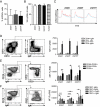Fcγ receptor IIB (FcγRIIB) maintains humoral tolerance in the human immune system in vivo
- PMID: 22065769
- PMCID: PMC3219118
- DOI: 10.1073/pnas.1111810108
Fcγ receptor IIB (FcγRIIB) maintains humoral tolerance in the human immune system in vivo
Erratum in
-
Correction for Baerenwaldt et al., Fcγ receptor IIB (FcγRIIB) maintains humoral tolerance in the human immune system in vivo.Proc Natl Acad Sci U S A. 2015 Aug 4;112(31):E4338. doi: 10.1073/pnas.1512312112. Epub 2015 Jul 13. Proc Natl Acad Sci U S A. 2015. PMID: 26170321 Free PMC article. No abstract available.
Abstract
Maintenance of immunological tolerance is crucial to prevent development of autoimmune disease. The production of autoantibodies is a hallmark of many autoimmune diseases and studies in mouse model systems suggest that inhibitory signaling molecules may be important checkpoints of humoral tolerance. By generating humanized mice with normal and functionally impaired Fcγ receptor IIB (FcγRIIB) variants, we show that the inhibitory Fcγ-receptor is a checkpoint of humoral tolerance in the human immune system in vivo. Impaired human FcγRIIB function resulted in the generation of higher levels of serum immunoglobulins, the production of different autoantibody specificities, and a higher proportion of human plasmablasts and plasma cells in vivo. Our results suggest that the inhibitory FcγRIIB may be an important checkpoint of humoral tolerance in the human immune system.
Conflict of interest statement
The authors declare no conflict of interest.
Figures




References
-
- Nimmerjahn F, Ravetch JV. Fcgamma receptors as regulators of immune responses. Nat Rev Immunol. 2008;8:34–47. - PubMed
-
- Takai T. Roles of Fc receptors in autoimmunity. Nat Rev Immunol. 2002;2:580–592. - PubMed
-
- Wardemann H, Nussenzweig MC. B-cell self-tolerance in humans. Adv Immunol. 2007;95:83–110. - PubMed
-
- Grimaldi CM, Hicks R, Diamond B. B cell selection and susceptibility to autoimmunity. J Immunol. 2005;174:1775–1781. - PubMed
Publication types
MeSH terms
Substances
LinkOut - more resources
Full Text Sources
Medical
Molecular Biology Databases

